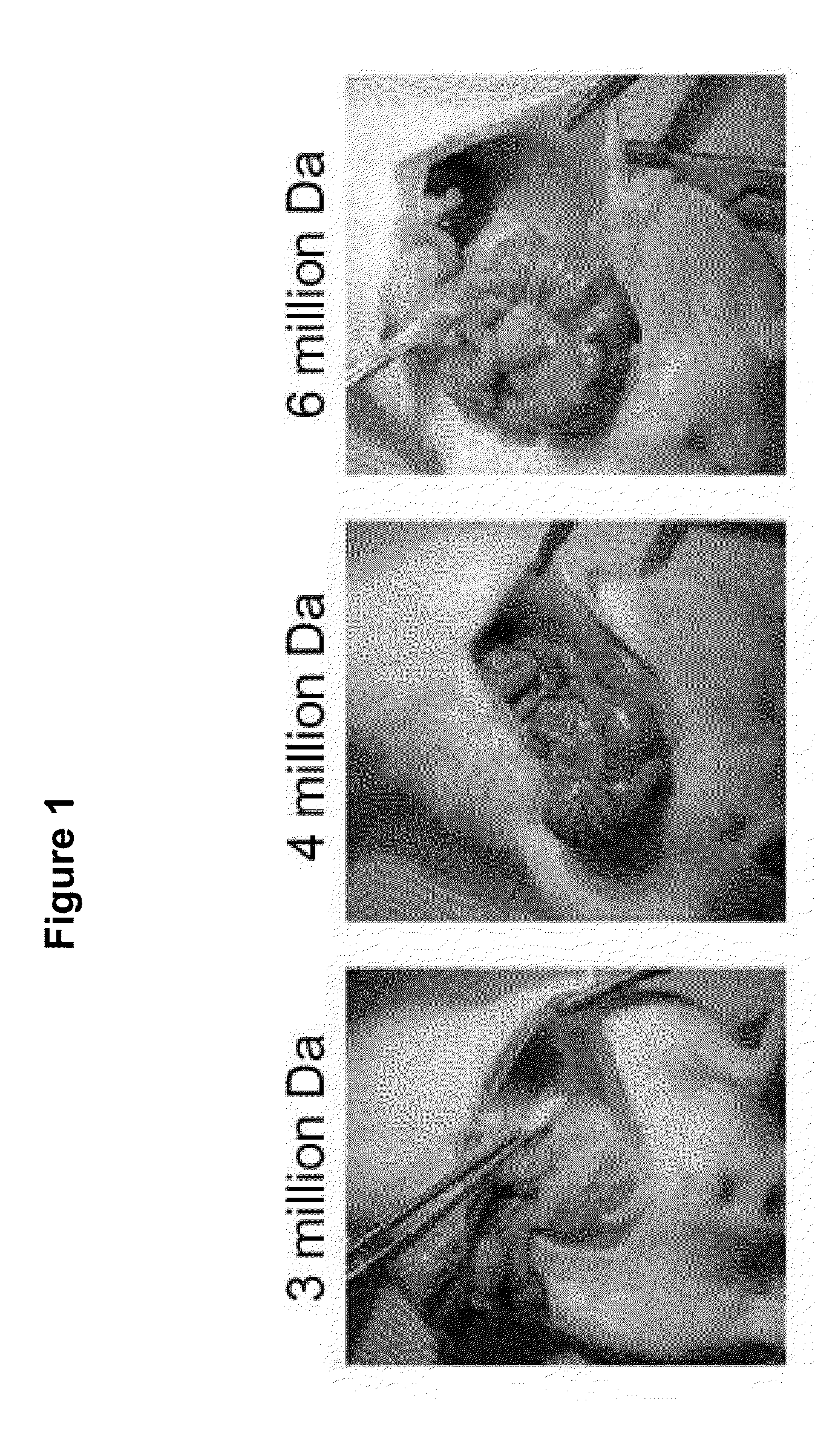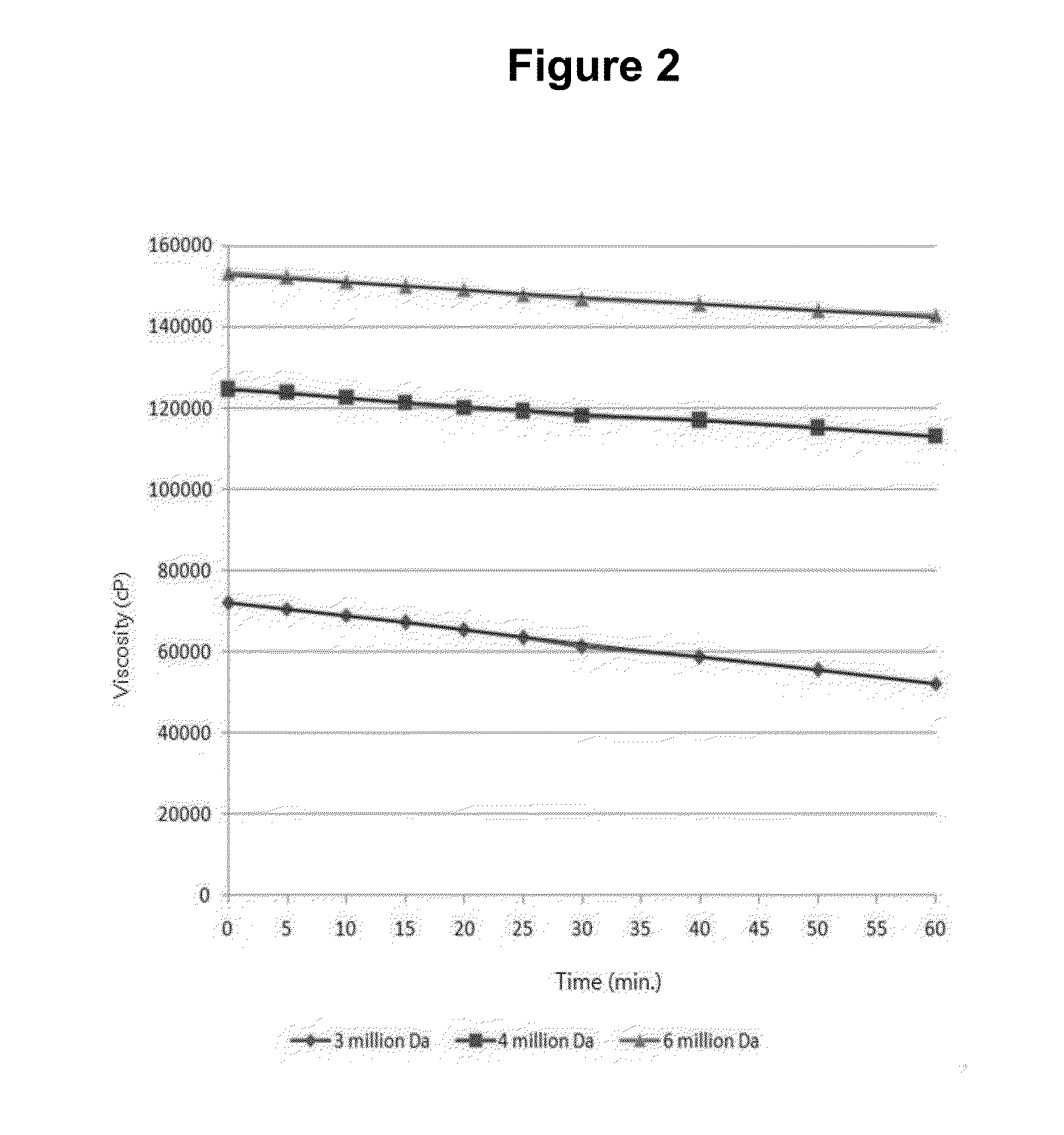Preparation method for hyaluronic acid, and Anti-adhesive composition comprising hyaluronic acid prepared by same preparation method
a technology of hyaluronic acid and preparation method, which is applied in the direction of drug compositions, prostheses, bacteria based processes, etc., can solve the problems of single use of non-cross-linked hyaluronic acid, adverse effects in the body, and difficulty in straightening thin films and dividing single films for the purpose of multiple use, etc., to achieve inhibit adhesion, prevent cross-linked hyaluronic acid from being used, and prolong the effect o
- Summary
- Abstract
- Description
- Claims
- Application Information
AI Technical Summary
Benefits of technology
Problems solved by technology
Method used
Image
Examples
example 1
Experiment on the Effect of Inhibiting Adhesion Based on the Molecular Weight of Hyaluronic Acid
[0080]SD rats (female, SPF, Orient Bio, Inc.) were anesthetized via inhalation and maintained under anesthesia throughout surgery. Their four limbs were tightly fixated on the operating table, followed by the removal of their abdominal hair with the aid of a razor. After disinfectants being applied, their abdomens were incised with operating scissors. Their appendixes were pulled out and rendered to be damaged by using coarse gauzes to the extent that the gauzes were smeared with bloodstains. The abdominal walls where the appendixes were located were also damaged in the same way as the appendixes, causing a condition where adhesion could occur between the appendixes and the internal abdominal walls. Test substances were administered and then the incision areas were sutured. After 2 weeks, laparotomy was performed to check the occurrence of adhesion. Said test substances included hyaluroni...
example 2
Basic Culturing Conditions for Producing High Molecular Weight Hyaluronic Acid
[0082]4 ml of Streptococcus dysgalactiae strain ID9103 culture solution stored in a −72° C. refrigerator was rapidly thawed, smeared on 5.2% brain heart infusion solid medium, and cultured at 37° C. for 24 hours. The grown colony was cut with an area of 1 cm2 and inoculated into 40 ml of 3% Todd-Hewitt broth sterilized liquid medium (heart, infusion 0.31%, neopeptone 2%, dextropse 0.2%, NaCl 0.2%, Disodium phosphate 0.04%, sodium carbonate 0.25%; BD, US).
[0083]40 ml of the liquid shake-cultured at 37° C. and 150rpm was used as a primary seed culture solution. In a Logarithmic growth phase following culturing for 6 hours, the primary seed liquid was aseptically inoculated to three 3% Todd-Hewitt broth sterilized liquid media (40 ml, pH 7.8). Under the culturing condition of 37° C. and 150rpm, after aseptic culturing for 20 hours or more, the cultured medium was used as a secondary seed culture solution. Her...
example 3
Productivity and Molecular Weight of High Molecular Weight Hyaluronic Acid
[0088]It has been known that nitrogen source plays an important role in the metabolism of microorganisms and also affects the production of hyaluronic acid. Hence, the present inventors reasoned that changing the types of amino acids including a class of peptones used as a basic nitrogen source might contribute to the production of hyaluronic acid having a molecular is weight of 4 million Da to 6 million Da as desired.
[0089]The present inventors confirmed that the concentration and the molecular weight of hyaluronic acid varied depending on the type of peptones. Among many different kinds of peptones, casein (enzymatic hydrolysate) used as the basic medium source lead to the best outcome, i.e. the production of hyaluronic acid having the concentration of 8 g / L or more and the molecular weight of 4,320,000 Da. Thus, all the experiments in following examples utilized casein (enzymatic hydrolysate).
[0090]The test...
PUM
| Property | Measurement | Unit |
|---|---|---|
| OD | aaaaa | aaaaa |
| pH | aaaaa | aaaaa |
| molecular weight | aaaaa | aaaaa |
Abstract
Description
Claims
Application Information
 Login to View More
Login to View More - R&D
- Intellectual Property
- Life Sciences
- Materials
- Tech Scout
- Unparalleled Data Quality
- Higher Quality Content
- 60% Fewer Hallucinations
Browse by: Latest US Patents, China's latest patents, Technical Efficacy Thesaurus, Application Domain, Technology Topic, Popular Technical Reports.
© 2025 PatSnap. All rights reserved.Legal|Privacy policy|Modern Slavery Act Transparency Statement|Sitemap|About US| Contact US: help@patsnap.com


